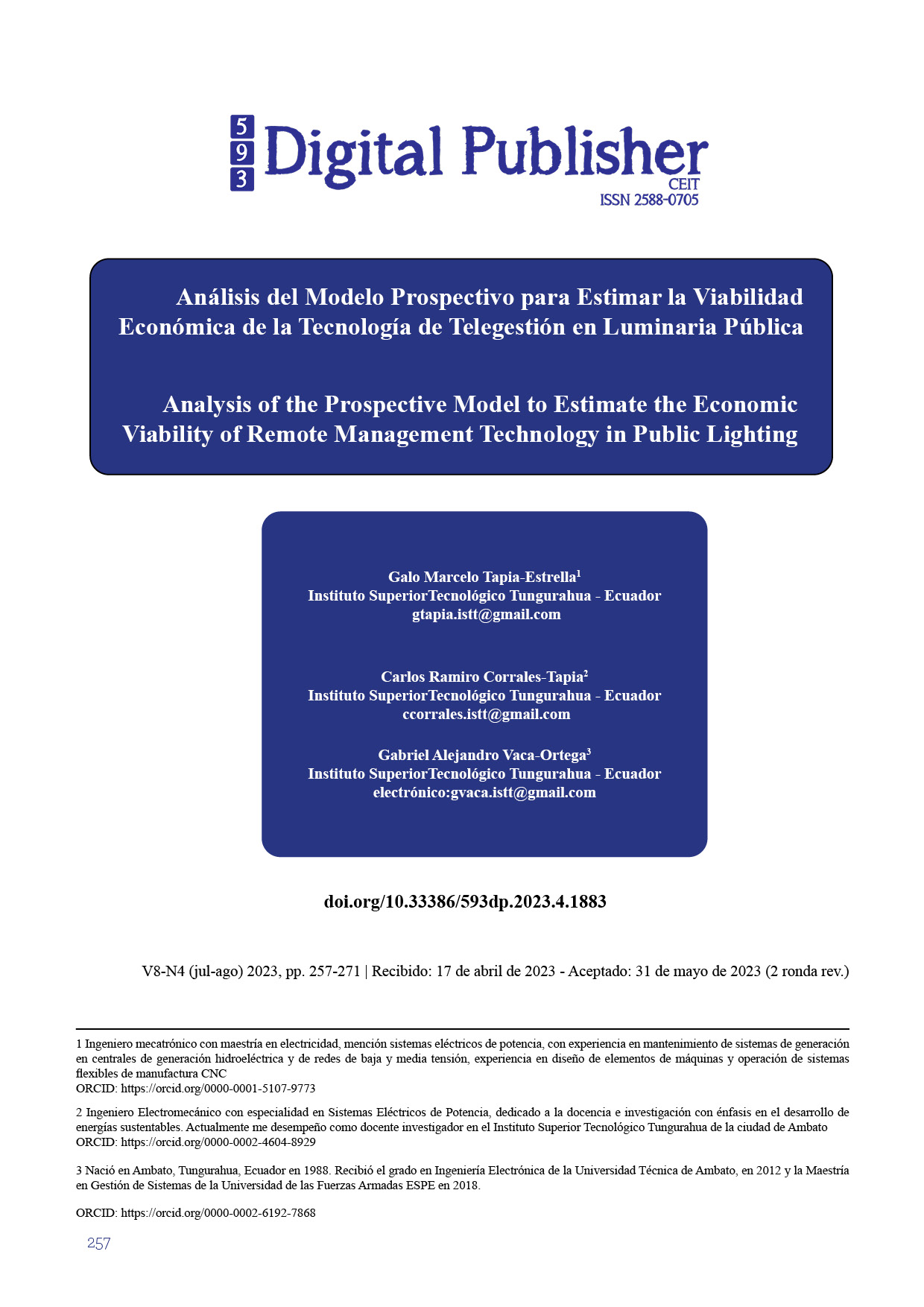Analysis of the Prospective Model to Estimate the Economic Viability of Remote Management Technology in Public Lighting
Main Article Content
Abstract
This article presents the results of a possible migration to LED lamps with remote management technology in public lighting in the province of Cotopaxi, for which the ELEPCO S.A. database is used. where the luminaires installed in the province are recorded, said database is updated annually, and having data from previous years, it is possible to apply the Holt-Winters model to estimate future energy consumption since public lighting is constantly growing Once short, medium and long-term consumption has been estimated, remote management migration projects are proposed and their impact is economically evaluated, deducing whether or not it is monetarily viable. The findings of the savings metrics obtained identified an improvement when migrating to LED technology, in addition to remote management to generate added value. In this sense, by replacing consumption with LED technology and remote management, a saving of 27.46% to 33.08% would be obtained, 18.25% more than with only migration to LED technology. It was concluded that the investment exceeds the savings during the life of the equipment.
Downloads
Article Details

This work is licensed under a Creative Commons Attribution-NonCommercial-ShareAlike 4.0 International License.
1. Derechos de autor
Las obras que se publican en 593 Digital Publisher CEIT están sujetas a los siguientes términos:
1.1. 593 Digital Publisher CEIT, conserva los derechos patrimoniales (copyright) de las obras publicadas, favorece y permite la reutilización de las mismas bajo la licencia Licencia Creative Commons 4.0 de Reconocimiento-NoComercial-CompartirIgual 4.0, por lo cual se pueden copiar, usar, difundir, transmitir y exponer públicamente, siempre que:
1.1.a. Se cite la autoría y fuente original de su publicación (revista, editorial, URL).
1.1.b. No se usen para fines comerciales u onerosos.
1.1.c. Se mencione la existencia y especificaciones de esta licencia de uso.
References
Abdullah, A., Yusoff, S. H., Zaini, S. A., Midi, N. S., & Mohamad, S. Y. (2019). Energy efficient smart streetlight for smart city using sensors and controller. Bulletin of Electrical Engineering and Informatics, 8(2), 558-568.
Acuña, H., & Konow, I. (1990). Métodos y Técnicas de investigación prospectiva para la toma de decisiones. Chile: FUNTURO.
ARCONEL. (2018). Regulación Nro. 054/2018. Quito.
CALIDAD, M. D. (2012). Reglamento técnico ecuatoriano RTE INEN 069 “alumbrado público”. Quito.
Dheena, P., Raj, G., Dutt, S. & Jinny V. (2017). IOT based smart street light management system. IEEE International Conference on Circuits and Systems (ICCS). 368-371, http:/10.1109/ICCS1.2017.8326023.
CONELEC. (2018). Regulación-No.-CONELEC-005_14-Prestación-APG. QUITO: CONELEC.
CRE (2008). Constitución De La República Del Ecuador. Quito.
Eriyadi, M., Abdullah, A. G., Hasbullah, H., & Mulia, S. B. (2021). Internet of things and fuzzy logic for smart street lighting prototypes. IAES International Journal of Artificial Intelligence (IJ-AI), 10(3), 528-538. 10.11591/ijai.v10.i3.pp528-538
Electricidad, C. N. (2016). Aspectos de sustentabilidad y sostenibilidad social y ambiental. Quito: CONELEC.
Esparza Catalán, C. (2018). Series Temporales. CSIC.
Flores Lora, R. O. (2018). Ahorro Energético en alumbrado público con el desarrollo de un prototipo de sistema de telegestión remoto para lamparas tipo Led de la Empresa Eléctrica MELNORTE S.A. Quito: EPN.
Gonzales Loaiza, P. D. (2014). "Telegestión del alumbrado público con tecnología LED". Loja-Ecuador: Universidad Nacional de Loja.
Miklos, T. (2015). Planeación prospectiva y estratégica. Mexico: Reduaz.
Ministerio de Turismo. (19 de Enero de 2019). Movimientos internos: geovit. Recuperado el 19 de Marzo de 2021, de https://servicios.turismo.gob.ec/boletin-coyuntural-de-alojamiento/8-turismo-en-cifras/movimientos-internos-geovit/289
Ocerin, J. C. (2012). Econometría: Modelos econométricos y series temporales . Barcelona : REVERTÉ S.A.
Panchi, A., & Tapia, G. (23 de Septiembre de 2021). Repositorio Digital Universidad Técnica de Cotopaxi. Recuperado el 24 de Febrero de 2023, de http://repositorio.utc.edu.ec/handle/27000/8015
Peréz, C. (2006). Econometria de las Series Temporales. PRENTICE-HALL.
Popa, M., & Marcu, A. (2021). A solution for street lighting in smart cities. Carpathian Journal of Electronic and Computer Engineering, 5, 91-104.
Popa, M., & Cepişcă, C. (2022). Energy consumption saving solutions based on intelligent street lighting control system. UPB Sci. Bull., Series C, 73(4), 297-308.
Renovables, M. d. (2019). Plan Maestro de Electricidad. II, 100.
Rodriguez, A. (2016). Telegestión Del Servicio De Alumbrado Público Inteligente Para El Parque Metropolitano El Tunal Ubicado En La Ciudad De Bogota. Bogota: Universidad De La Salle.
Rueda Flores, J. A. (2020). Análisis De Factibilidad Técnica Para La Implementación De Un Sistema De Telegestión Que Permita El Uso Eficiente De La Energía Del Alumbrado Público En El Centro Histórico De Ibarra Concesión De La Empresa Eléctrica Emelnorte S.A. Latacunga: ESPE.
Sumathi, V., Sandeep, A. K., & Kumar, B. T. (2013). Arm based street lighting system with fault detection. International Journal of Engineering and Technology, 5(5), 4141-4144.
Tama Franco, A. (2012). La revolución del alumbrado público. Quito: ESPOL.




